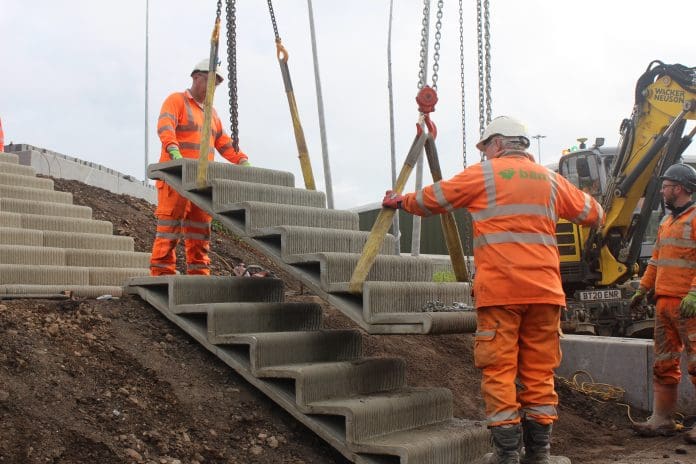As the demands for sustainability, efficiency, and cost-effectiveness soar, the role of innovative construction technologies has never been more necessary, explains Colin Evison, head of innovation at BAM UK & Ireland
Construction technologies, including generative artificial intelligence (AI), are increasingly becoming leveraged within the sector, proving a “pivotal moment” for the industry.
We only have to look at the launch of the UK Government’s new framework for harnessing AI to boost public project delivery to see that the use of new technology is on the rise, moulding the sector into a new shape.
Yet, no single piece of technology will transform outcomes within the sector—improvement lies in the individual innovative practices that are slowly incorporated into day-to-day site work.
Fortunately, there are multiple examples to explore how these modern methods have been and can be made possible through construction technologies.
Here are four examples of how BAM has used technology to improve risk management for clients, construct buildings with minimal disruption to critical operations on projects, accelerate planning processes by using virtual walkthroughs, and ensure that workers are not navigating difficult terrain by deploying robotics on site.
Putting AI into practice
Using AI as an example, it is poised to significantly enhance the efficiency of construction companies by introducing generative design, which is bound to have a positive impact on client work.
However, there is still a long way to go – 55% of chief operating officers in the sector indicated that the main barrier to creating business value with AI was identifying the right opportunities to apply it.
The challenge lies in recognising the right situations where AI can have a tangible, positive impact on the company’s performance. In practice, it can provide simple planning efficiencies as well as on-the-ground support.
Last summer, BAM trialled the use of several AI tools, including work with nPlan to quantify and tackle potential issues within a portfolio of projects.
Using AI, BAM improved its risk management of the outcome of 50 projects by analysing potential risks and associated costs, enabling the firm to take prompt preventive action.
Improving risk management through AI significantly enhances safety, which reduces the likelihood of accidents and ensures compliance with safety regulations, such as the latest Building Safety Act, which took effect in October last year.
This anticipation and mitigation of potential problems ahead of time ensures a smoother, more predictable construction process for clients.
Using 3D modelling on large-scale projects
When we take AI one step further and explore its capabilities of 3D visualisation, we can also see how it can facilitate the planning side of construction projects.
For example, when building the Sighthill Bridge across the M8 in Glasgow, BAM used 3D concrete printing to create the staircase that provided access to the bridge.
Printing allowed for precise and intricate shapes to be made, which can be difficult with traditional formwork.
The removal of moulds and materials also reduced waste by 40% compared to traditional methods, keeping costs down whilst improving carbon efficiency.
3D modelling has proven to be a valuable tool in healthcare, too. In the construction of medical facilities, such as the Skyway Link Bridge at Southampton Hospital, the technology has allowed necessary construction to take place with minimal disruption to critical operations.
At Southampton Hospital, 3D modelling produced a digital replication of the bridge, enabling the team to preemptively address potential issues ahead of time and ensure seamless integration into the hospital’s existing infrastructure.
Planning through the lens of augmented reality (AR) and virtual reality (VR)
Similar to the method of using 3D modelling, the use of AR and VR in construction projects has massively streamlined the planning process of construction work.
When BAM was tasked with strengthening and improving the access to the King Edward Bridge in Newcastle, the biggest concern was ensuring the safety of those with boots on the ground.
The structure is high and has low handrails, so construction workers had to crawl on their hands and knees to stay safe.
By using AR and VR, BAM was able to facilitate virtual walkthroughs of project plans and foresee the potential changes, reducing the need for on-site visits and accelerating the planning process.
In addition, when it comes to large-scale projects, several stakeholders, such as local authorities, clients, architects, and contractors, are often involved who want to oversee construction methods and outcomes to ensure that work is meeting the needs of the local community.
This new technology has proved an effective presentation tool for communicating construction plans to stakeholders and enhancing decision-making. It allows those involved to see the changes on site and how the impossible can be possible.
The place for robotics in engineering
When it comes to modern methods of technology, the introduction of robotics has certainly caught the attention of the construction industry. With reports of bricklaying robots and pothole-fixing robots, there has been a keen eye on the outcome of their performance.
When implemented, robotic technologies are proving to be effective.
Agile mobile robots—often referred to as robotic dogs—are now being deployed to navigate difficult terrain and confined spaces within construction sites that are deemed too hazardous for people.
A robotic dog named Spot was fitted with in-built laser scanners and put to work by BAM on a remote construction site in Shetland. The four-legged robot used customised 3D laser scanning equipment to collect data and create records of the 55,176m2 area, whilst being controlled remotely via 5G signal.
The successful use of Spot in this isolated location with harsh weather conditions and challenging terrain demonstrates that some tasks on sites can be automated or undertaken remotely, reducing the need for people to travel to difficult locations.
This has not been the only deployment of Spot – recently, it has been used by BAM to survey a former atomic bomb test site in Suffolk on behalf of the National Trust, as these facilities were deemed unsafe to enter due to decaying concrete. Spot has also worked with National Highways to inspect potentially hazardous roadside locations.
Whilst the use of robotics can help strengthen worker safety and innovation within the sector, it cannot replace the need for workers in the project. According to a report by Goldman Sachs, AI and robotic technology can only handle 25% of “unpredictable physical work” – a skill that is vital on construction sites.
The robotic technology will likely augment human labour rather than replace it entirely because the value of human judgment, expertise, and adaptability remains crucial in the industry.
Each of these new technologies—AI, 3D modelling, AR, VR, and robotics—offers distinct advantages. When integrated fully, construction projects will see more efficient, cost-effective solutions that improve worker safety.
When used holistically, they will not only reshape individual projects but also improve outcomes within the construction industry and collectively set new standards for the entire sector—standards focused on safety and efficiency while making construction work possible.

















